PONTIAC BONNEVILLE 1998 Owners Manual
Manufacturer: PONTIAC, Model Year: 1998, Model line: BONNEVILLE, Model: PONTIAC BONNEVILLE 1998Pages: 395, PDF Size: 17.6 MB
Page 261 of 395
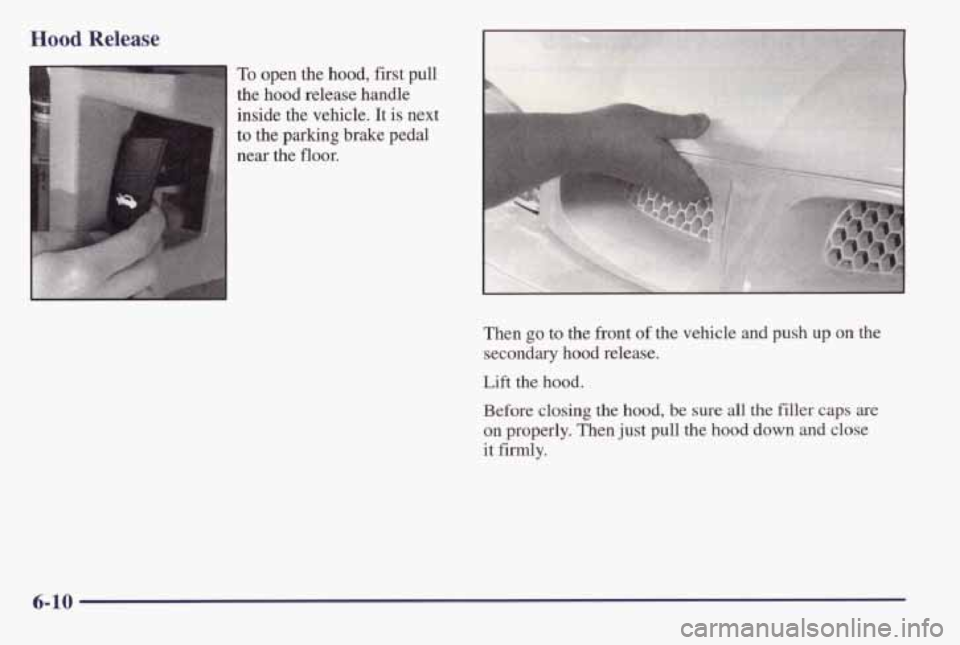
Hood Release
To open the hood, fist pull
the hood release handle
inside
the vehicle. It is next
to the parking brake pedal
Then
go to the front of the vehicle and push up on the
secondary hood release.
Lift the hood.
Before closing
the hood, be sure all the filler caps are
on properly. Then just pull the hood down and close
it firmly.
6-10
Page 262 of 395
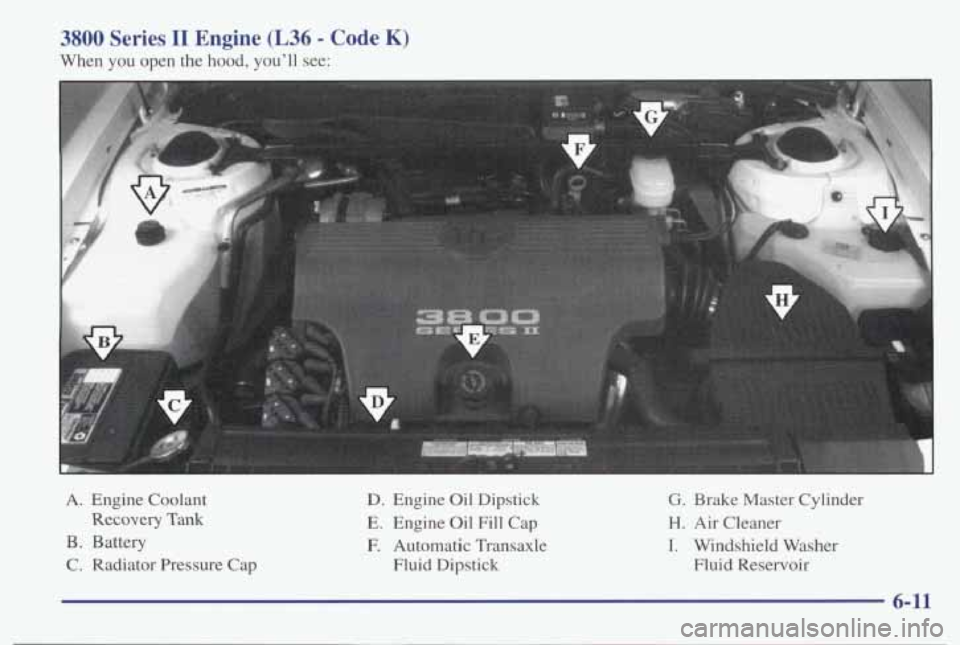
3800 Series I1 Engine (L36 - Code K)
When you open the hood, you'll see:
A. Engine Coolant
Recovery Tank
B. Battery
C. Radiator Pressure Cap
D. Engine Oil Dipstick
E. Engine Oil Fill Cap
E Automatic Transaxle
Fluid Dipstick
G. Brake Master Cylinder
H. Air Cleaner
I. Windshield Washer
Fluid Reservoir
6-11
Page 263 of 395
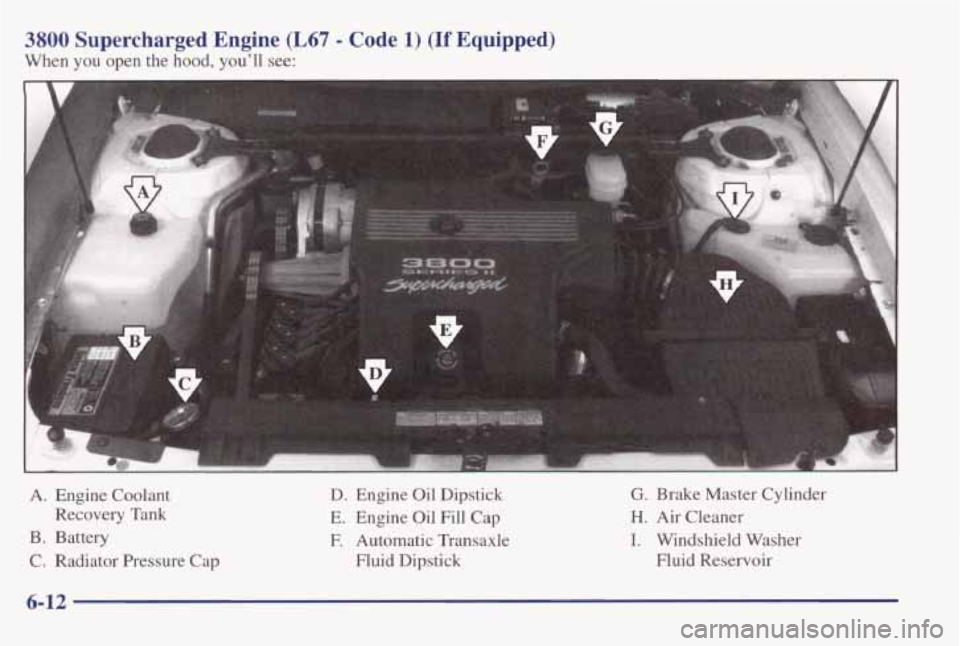
3800 Supercharged Engine (L67 - Code 1) (If Equipped)
When you open the hood, you’ll see:
A. Engine Coolant
Recovery Tank
B. Battery
C. Radiator Pressure Cap D. Engine Oil Dipstick G. Brake Master Cylinder
E. Engine Oil Fill Cap
H. Air Cleaner
E Automatic Transaxle I. Windshield Washer
Fluid Dipstick Fluid Reservoir
Page 264 of 395
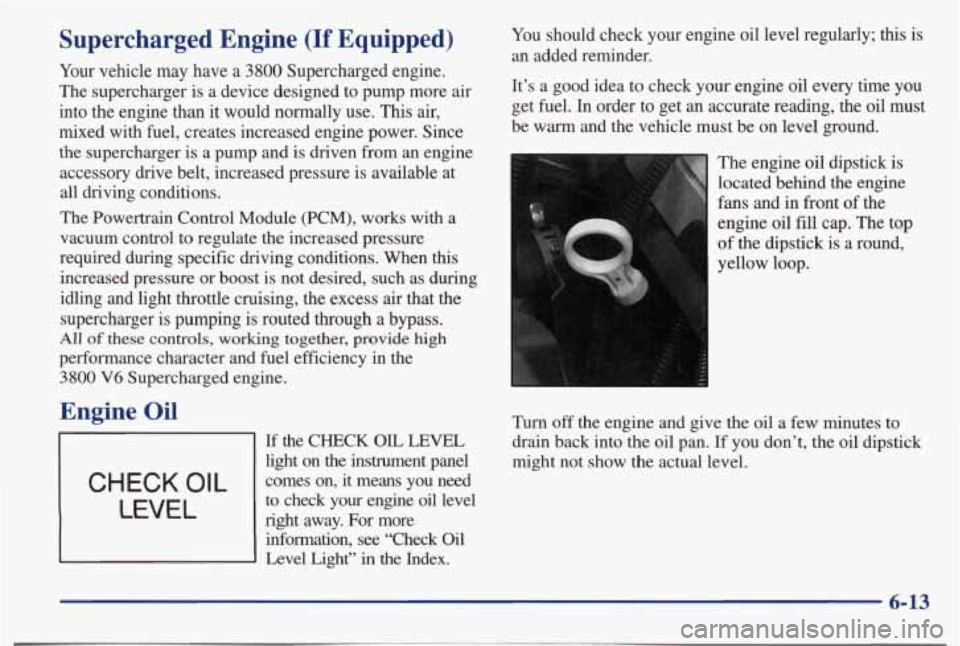
Supercharged Engine (If Equipped)
Your vehicle may have a 3800 Supercharged engine.
The supercharger is a device designed to pump more air
into the engine than it would normally use.
This air,
mixed with fuel, creates increased engine power. Since
the supercharger is a pump and is driven from an engine
accessory drive belt, increased pressure is available at
all driving conditions.
The Powertrain Control Module (PCM), works with a vacuum control to regulate the increased pressure
required during specific driving conditions. When this
increased pressure or boost is not desired, such
as during
idling and light throttle cruising, the excess
air that the
supercharger is pumping is routed through
a bypass.
All of these controls, working together, provide high
performance character and fuel efficiency in the
3800 V6 Supercharged engine.
Engine Oil
CHECK OIL
LEVEL
If the CHECK OIL LEVEL
light on the instrument panel
comes
on, it means you need
to check your engine oil level
right away.
For more
information,
see “Check Oil
Level Light” in the Index. You
should check your engine oil level regularly;
this is
an added reminder.
It’s
a good idea to check your engine oil every time you
get fuel.
In order to get an accurate reading, the oil must
be warm and the vehicle must be on level ground.
Turn
off the engine and give the oil a few minutes to
drain back into the oil pan. If you don’t, the oil dipstic\
k
might not show
the actual level.
6-13
Page 265 of 395
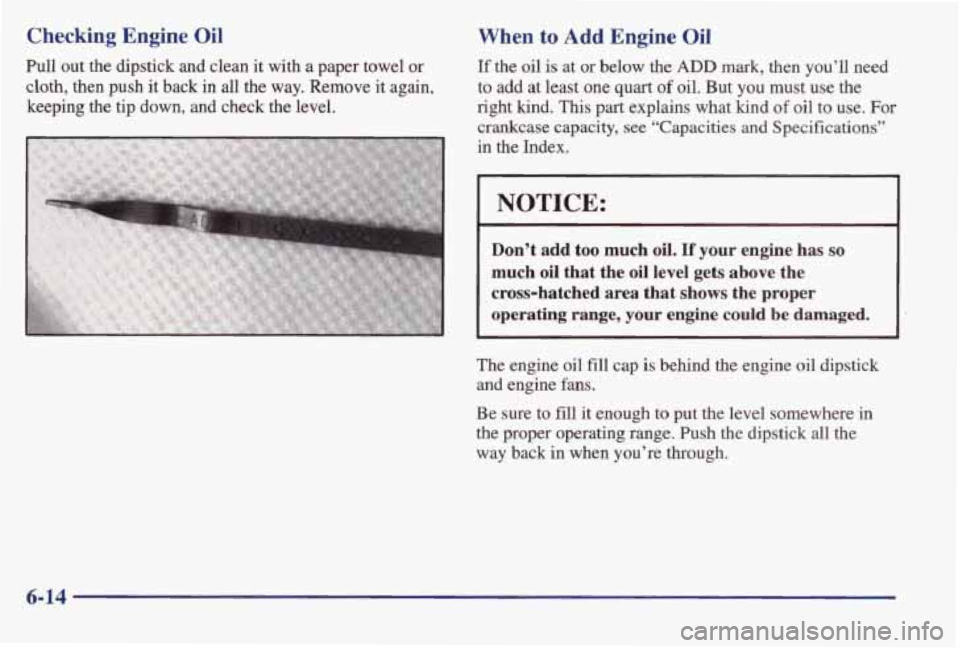
Checking Engine Oil
Pull out the dipstick and clean it with a paper towel or
cloth, then push it back in all the way. Remove it again,
keeping the
tip down, and check the level.
When to Add Engine Oil
If the oil is at or below the ADD mark, then you’ll need
to add at least one quart
of oil. But you must use the
right kind.
This part explains what kind of oil to use. For
crankcase capacity, see “Capacities and Specifications”
in the Index.
NOTICE:
Don’t add too much oil. If your engine has so
much oil that the oil level gets above the
cross-hatched
area that shows the proper
operating
range, your engine could be damaged.
The engine oil fill cap is behind the engine oil dipstick
and engine fans.
Be sure to fill it enough to put the level somewhere in
the proper operating range.
Push the dipstick all the
way back
in when you’re through.
6-14
Page 266 of 395
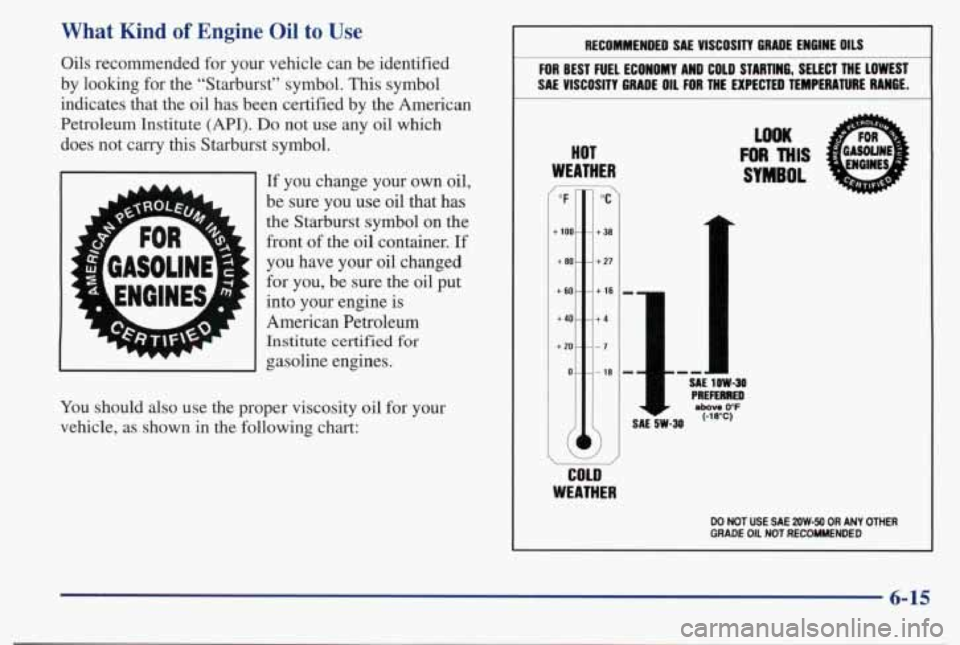
What Kind of Engine Oil to Use
Oils recommended for your vehicle can be identified
by looking for the "Starburst" symbol. This symbol
indicates that the oil has been certified by the American
Petroleum Institute
(API). Do not use any oil which
does not carry this Starburst symbol.
i A
If you change your own oil,
be sure you use oil that has the Starburst symbol on the
front of the oil container.
If
you have your oil changed
for you, be sure the oil put
into your engine is
American Petroleum
Institute certified for
gasoline engines.
You should
also use the proper viscosity oil for your
vehicle, as shown in the following chart:
RECOMMENDED SAE VISCOSITY GRADE ENGINE OILS
FOR BEST FUEL ECONOMY AND COLD STARTIN& SELECT THE LOWEST
SA€ VISCOSITY GRADE OIL FOR THE EXPECTED TEMPERATURE RAWGE.
HOT
WEATHER 7
"F
t 100 -
+80-
+60-
t40-
t 20 -
0-
7
"C
t3a
t
27
t 16
+I
-1
- 18
cou)
WEATHER
WOK
FOR THIS
SYMBOL
DO NOT USE SM 2QW-50 OR ANY OTHER GRADE OIL NOTRECaYlENMD
6-15
Page 267 of 395
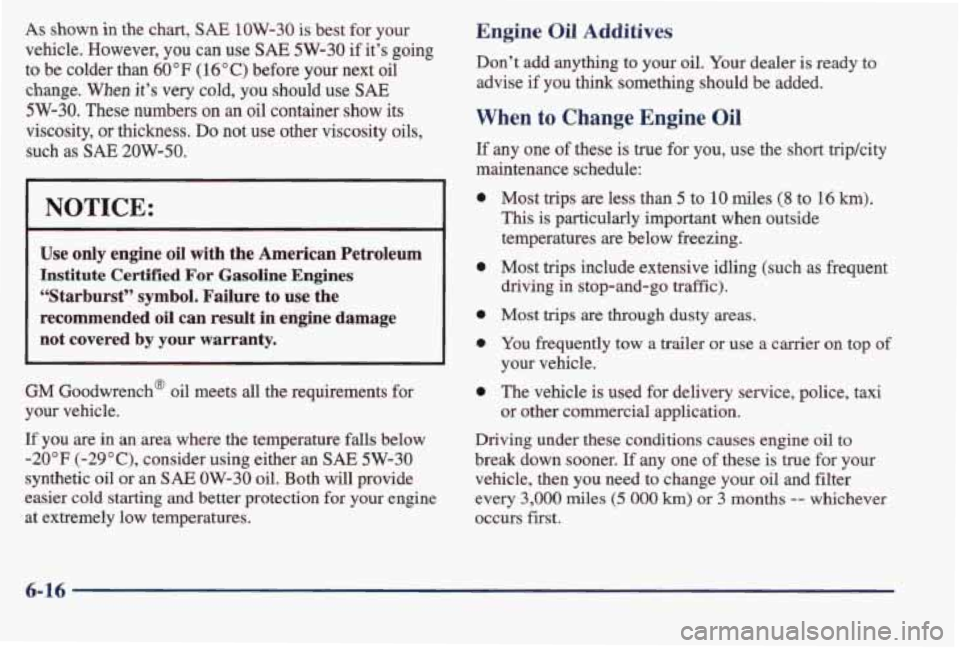
As shown in the chart, SAE 1OW-30 is best for your
vehicle. However,
you can use SAE 5W-30 if it's going
to be colder
than 60 "F (1 6" C) before your next oil
change. When it's very cold, you should use SAE
5W-30. These numbers on an oil container show its
viscosity,
or thickness. Do not use other viscosity oils,
such as
SAE 20W-50.
NOTICE:
Use only engine oil with the American Petroleum
Institute Certified For Gasoline Engines
"Starburst" symbol. Failure to use the
recommended
oil can result in engine damage
not covered by your warranty.
GM Goodwrench@ oil meets all the requirements for
your vehicle.
If you are in an area where the temperature falls below
-20°F (-29"C), consider using either an SAE 5W-30
synthetic oil or an SAE OW-30 oil. Both will provide
easier cold starting
and better protection for your engine
at extremely low temperatures.
Engine Oil Additives
Don't add anything to your oil. Your dealer is ready to
advise if you
think something should be added.
When to Change Engine Oil
If any one of these is true for you, use the short tripkity
maintenance schedule:
0
0
0
0
0
Most tsips are less than 5 to 10 miles (8 to 16 lun).
This is particularly important when outside
temperatures are below freezing.
Most
trips include extensive idling (such as fiequent
driving
in stop-and-go traffic).
Most trips are through dusty areas.
You frequently tow a trailer or use a carrier on top of
your vehicle.
The vehicle
is used for delivery service, police, taxi
or other commercial application.
Driving under these conditions causes engine oil to
break down sooner.
If any one of these is true for your
vehicle,
then you need to change your oil and filter
every
3,000 miles (5 000 km) or 3 months -- whichever
occurs
first.
6-16
Page 268 of 395
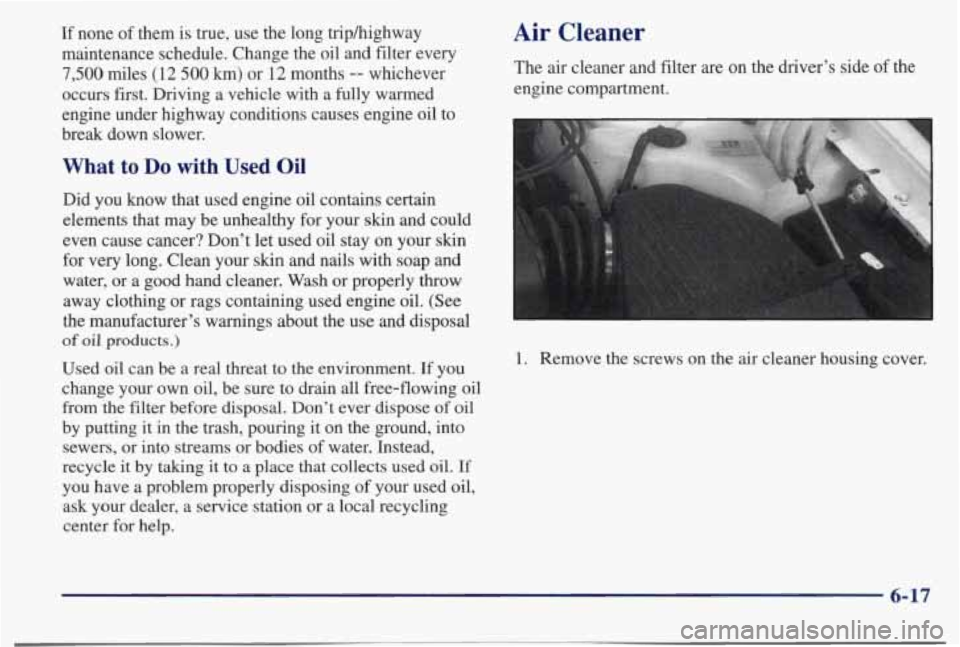
If none of them is true, use the long triphighway
maintenance schedule. Change the oil and filter every
7,500 miles (12 500 km) or 12 months -- whichever
occurs first. Driving a vehicle with a fully warmed
engine under highway conditions causes engine oil to
break down slower.
What to Do with Used Oil
Did you know that used engine oil contains certain
elements that may be unhealthy for your
skin and could
even cause cancer? Don’t let used oil stay on your skin
for very long. Clean your
skin and nails with soap and
water, or a
good hand cleaner. Wash or properly throw
away clothing or rags containing used engine oil. (See
the manufacturer’s warnings about the use and
disposal
of oil products.)
Used oil can be a real threat to the environment. If you
change your own oil, be sure to drain all free-flowing oil
from
the filter before disposal. Don’t ever dispose of oil
by putting it in the trash, pouring it on the ground, into
sewers, or into streams or bodies of water. Instead,
recycle
it by taking it to a place that collects used oil. If
you have a problem properly disposing of your used oil,
ask your dealer, a service station or a local recycling
center for
help.
Air Cleaner
The air cleaner and filter are on the driver’s side of the
engine compartment.
1. Remove the screws on the air cleaner housing cover.
6-17
Page 269 of 395
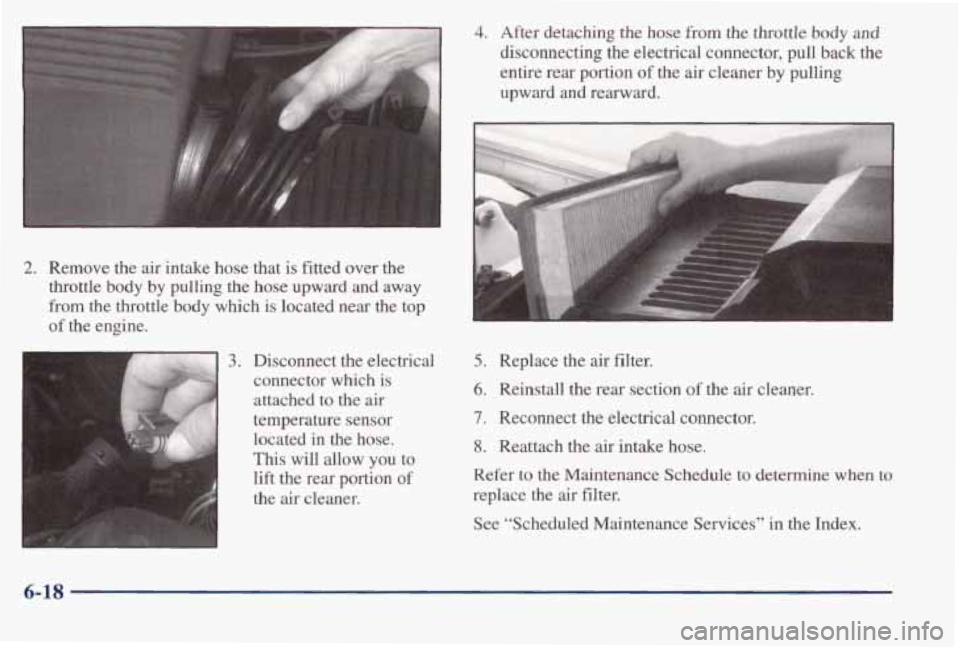
2. Remove the air intake hose that is fitted over the
throttle body by pulling the hose upward and away
from the throttle body which is located near the top
of the engine.
3. Disconnect the electrical
connector which is
attached to the air
temperature sensor
located in the hose.
This will allow you to
lift
the rear portion of
the air cleaner.
4. After detaching the hose from the throttle body and
disconnecting the electrical connector, pull back the
entire rear portion of the air cleaner by pulling
upward and rearward.
5. Replace the air filter.
6. Reinstall the rear section of the air cleaner.
7. Reconnect the electrical connector.
8. Reattach the air intake hose.
Refer to the Maintenance Schedule
to determine when to
replace the
air filter.
See “Scheduled Maintenance Services” in the Index.
6-18
Page 270 of 395
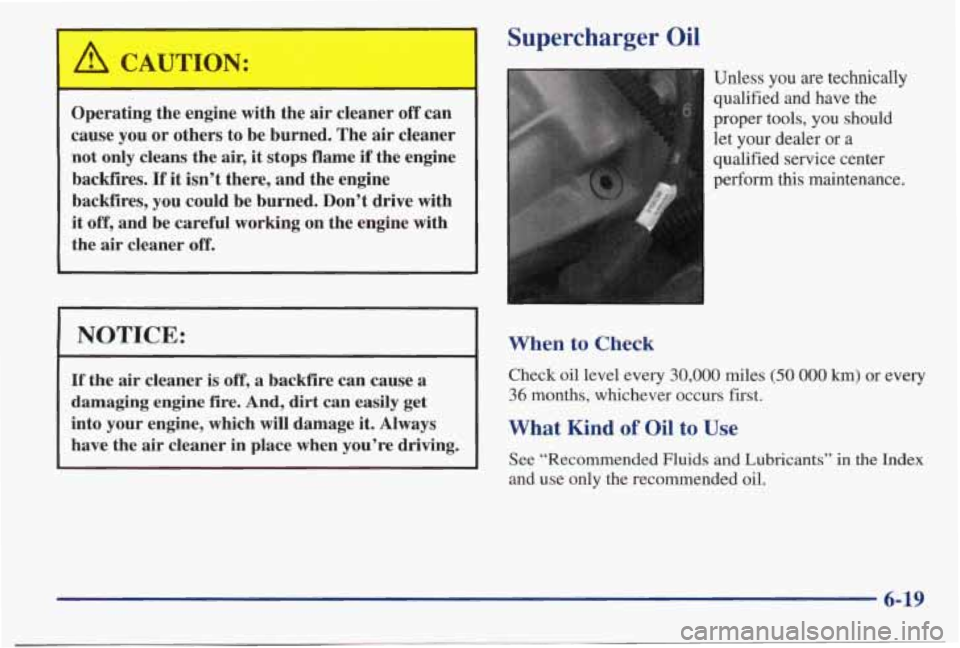
/r CAUTION:
- I
Operating the engine with the air cleaner off can
cause you or others to be burned. The air cleaner
not only cleans the air, it
stops flame if the engine
backfires.
If it isn’t there, and the engine
backfires, you could be burned. Don’t drive with
it
off, and be careful working on the engine with
the air cleaner
off.
I NOTICE:
If the air cleaner is off, a backfire can cause a
damaging engine fire. And, dirt can easily get
into your engine, which
will damage it. Always
have the air cleaner in place when you’re driving.
Supercharger Oil
Unless you are technically
qualified and have the
proper tools, you should
let your dealer or a
qualified service center
perform this maintenance.
When to Check
Check oil level every 30,000 miles (50 000 km) or every
36 months, whichever occurs first.
What Kind of Oil to Use
See “Recommended Fluids and Lubricants” in the Index
and use only the recommended oil.